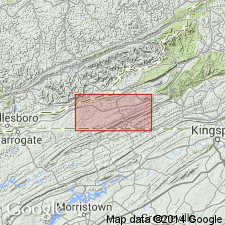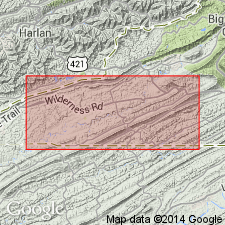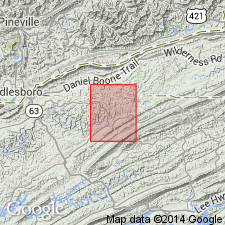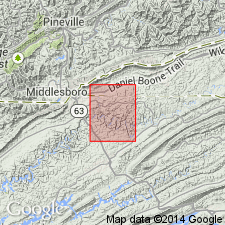
- Usage in publication:
-
- Ben Hur limestone*
- Modifications:
-
- Named
- Dominant lithology:
-
- Limestone
- AAPG geologic province:
-
- Appalachian basin
Summary:
Named the Ben Hur limestone for Ben Hur, Lee Co., VA. Consists of buff-weathering shaly limestone with a few interbeds of purer crystalline limestone. Thickness is 127 to 153 feet. Unit overlies the Woodway limestone and underlies the Hardy Creek limestone. The Ben Hur is of Middle Ordovician age.
Source: GNU records (USGS DDS-6; Reston GNULEX).

- Usage in publication:
-
- Ben Hur limestone*
- Modifications:
-
- Principal reference
- AAPG geologic province:
-
- Appalachian basin
Summary:
The type section of the Ben Hur limestone is designated as along railroad cut of Louisville and Nashville Railroad, 1000 feet west of railroad station at Ben Hur, Lee Co., VA. Thickness of the unit at the type section is 125 feet. Paper discusses correlation problems and contains a summary of nomenclature of Middle Ordovician formations in Lee and Tazewell Cos., VA.
Source: GNU records (USGS DDS-6; Reston GNULEX).

- Usage in publication:
-
- Ben Hur limestone*
- Modifications:
-
- Areal extent
- AAPG geologic province:
-
- Appalachian basin
Summary:
Geographically extended the Ben Hur limestone into northeastern TN. Consists of yellowish-gray, hackly weathering, argillaceous limestone with some interbedded (2 to 6 inch thick) olive-gray calcilutite. Thickness is 135 feet in the Coleman Gap quad. Unit overlies the Woodway limestone and underlies the Hardy Creek limestone. The Ben Hur is of Middle Ordovician age.
Source: GNU records (USGS DDS-6; Reston GNULEX).

- Usage in publication:
-
- Ben Hur Limestone*
- Modifications:
-
- Revised
- AAPG geologic province:
-
- Appalachian basin
Summary:
Revised the Ben Hur Limestone as a formation within the Chickamauga Group. The Chickamauga Group in this area includes, and contains all the units between, the Dot Formation and Reedsville Shale. The Ben Hur consists of yellowish-gray, argillaceous limestone with some interbedded olive-gray calcilutite, especially prominent in the middle part of the unit. Thickness is 135 feet. Unit overlies the Woodway Limestone and underlies the Hardy Creek Limestone, both of the Chickamauga Group. The Ben Hur is of Middle Ordovician age.
Source: GNU records (USGS DDS-6; Reston GNULEX).
For more information, please contact Nancy Stamm, Geologic Names Committee Secretary.
Asterisk (*) indicates published by U.S. Geological Survey authors.
"No current usage" (†) implies that a name has been abandoned or has fallen into disuse. Former usage and, if known, replacement name given in parentheses ( ).
Slash (/) indicates name conflicts with nomenclatural guidelines (CSN, 1933; ACSN, 1961, 1970; NACSN, 1983, 2005, 2021). May be explained within brackets ([ ]).

